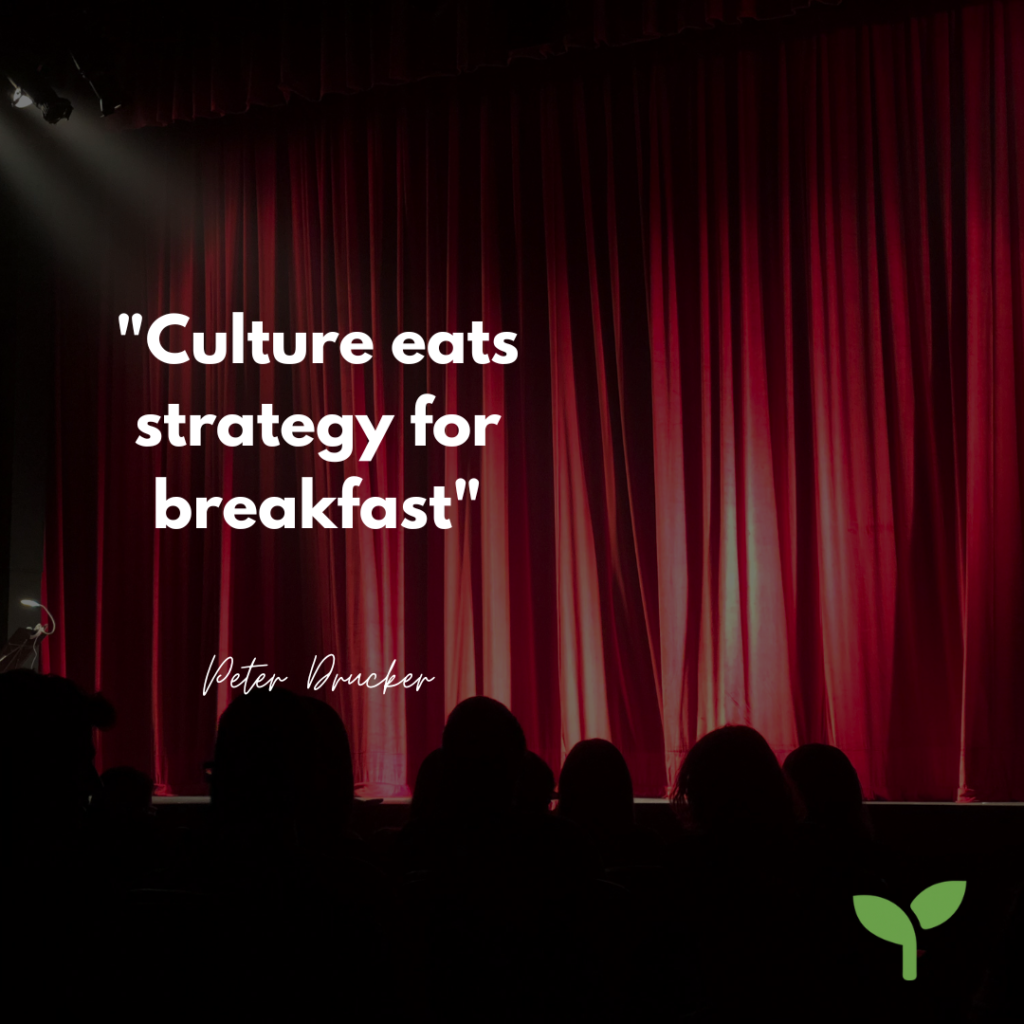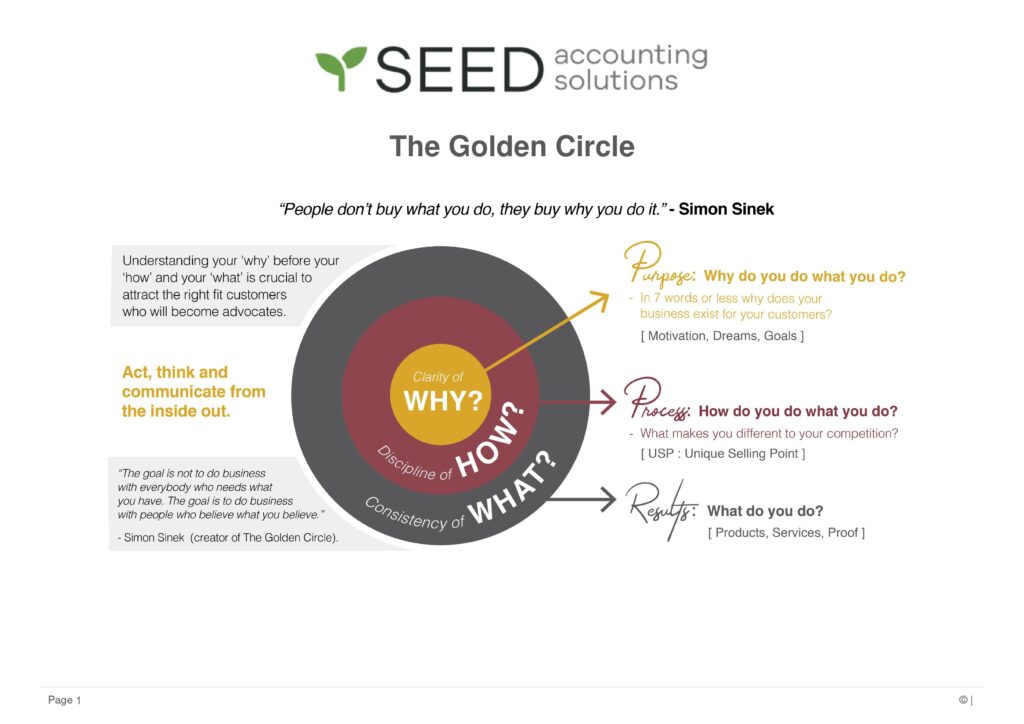
The Productivity Pyramid
24th January 2023
Top 7 Small Business Accountancy Tips
16th February 2023No matter how great your strategy is, if you don’t have the right culture in your workplace, you simply won’t get great results. This blog post is about the three most influential drivers of a positive culture: your Vision, your Purpose, and your Core Values.

The cornerstone of culture
So, why is workplace culture so important? Studies have shown that businesses with a great culture and an engaged team significantly outperform those without.
Your vision, your purpose, and your values are three key elements of culture. When you spend time developing these, sharing them with your team, and ensuring you and your team truly believe and live into them, you’ll create a sense of belonging for your team and your customers and build alignment throughout your business.
You can use these cornerstones as a filter for decision making, recruitment, and ensuring customers are the right fit for your business. Let’s have a closer look at each one.
Vision
The first cornerstone of culture is your vision.
According to research published in the Harvard Business Review evaluating tens of thousands of working people around the world, effectively enlisting the hearts and minds of your organisation in a shared vision of the future differentiates leaders from non-leaders.
In short, companies without an effective strategic vision struggle to provide a meaningful context for their goals, strategies and implementation plans.
Jim Collins, a celebrated author, speaker and consultant, developed the concept of your vision comprising your Core Ideology and your Envisioned Future.
To break this down even further, your Core Ideology consists of your Core Purpose and your Core Values.
It’s the enduring character of your business; a consistent identity that transcends product or market lifecycles, management fads, and individual leaders.
Your Envisioned Future translates your Core Ideology into a tangible goal; it’s made up of a 10-30 year BHAG and vivid descriptions. A BHAG is a Big Hairy Audacious Goal, in other words a goal so big that you’re forced to dramatically improve, or you won’t be able to achieve it. It should be a goal which may only have a 50-70% chance of achievement, but one which you truly believe you can achieve. It should be concise and easy to understand.
Vivid descriptions are essential to make your BHAG tangible. They should paint a picture of what it will look like to achieve your BHAG.
To use Jim Collins words, your Envisioned Future should be so exciting in its own right that it would continue to keep the organisation motivated, even if the leaders who set the goal disappeared.
Each part is essential for success; without progression towards a desired future state, your purpose and values become meaningless. But your future vision can’t be achieved without the stable foundation created by your purpose and values.
Your Vision Statement
So, how do you articulate your vision?
Here are some important guidelines for developing a clear vision statement, derived from Change Factory:
-
- Write it in the present tense, not future tense.
- Summarise your vision in a powerful phrase.
- Describe an outcome – the best outcome you can achieve.
- Use unambiguous language which is easy to understand.
- Evoke emotion – it should be obviously and unashamedly passionate.
- It must help to build the same picture in people’s minds.
Here are some examples of great vision statements…
Tesla’s vision is to “create the most compelling car company of the 21st century by driving the world’s transition to electric vehicles”.
Nike’s vision is to “bring inspiration and innovation to every athlete* in the world”. And they’ve defined an athlete as “if you have a body, you are an athlete”.
LinkedIn’s vision is to create economic opportunity for every member of the global workforce.
Purpose
The second cornerstone of culture is your Purpose.
Your Purpose is why your business exists for your customers, summarised in 7 words or less. Or, simply put, your ‘why’.
Of course your business exists to make a profit, but this is not your Purpose.
Your Purpose is your reason for being, not a goal or business strategy. It’s extremely important because, as Simon Sinek says, “people don’t buy what you do, they buy why you do it” – which leads me to The Golden Circle.

To better understand your Purpose, let’s look at The Golden Circle, created by Simon Sinek.
Most businesses first describe what it is they do.
Followed by how they do it.
They often fail to talk about why the business exists for their customers.
It’s important to communicate from the inside out, building an emotional connection with customers.
So, how do you describe your ‘why’ or core purpose?
This should be 5-7 words defining why you exist for your customers. When you have a clear purpose that your team understands, it’s much easier to achieve alignment of thinking.
When you’ve articulated your purpose, you can then talk about the how; your unique selling point or brand promise…
…and, when customers understand your why and how, you can then discuss the what; the products or services you offer to achieve your why.
Here are five characteristics of a good purpose, according to Jim Collins:
-
- It must be inspiring to your whole team. Everyone on your team should not only know your Purpose, they should believe in it.
- It must be as valid in 100 years as it is now. This means it needs to be broad enough to capture what you do but not specific to your products or services.
- It should help you consider what you could be doing, but aren’t. What products or services could you offer which will help you live into your Purpose while staying relevant to what customers want?
- It should help you decide what not to do. Are your new product or service ideas relevant to your Purpose? If not, should you really start them?
- It should be truly authentic to your business. You can’t copy someone else’s Purpose and you can’t make one up thinking it’s what your customers want to hear. You must live into your Purpose.
Let’s look at some examples of purpose statements.
Tesla’s is to accelerate the world’s transition to sustainable energy. Notice how their purpose doesn’t actually mention vehicles? This opens Tesla up to other opportunities in the sustainable energy industry.
Netflix’s purpose is to entertain the world.
Zoom’s is to make video communications frictionless and secure.
You can see how these would be inspiring to their team, will be valid in 100 years, helps them think about what they could be doing, helps them decide what not to do, and are truly authentic to the business.
Core Values
The third cornerstone of culture is your Core Values.
These are timeless, guiding principles that speak from the heart of your business. Your Core Values are almost like a set of fundamental rules of engagement for you, your team and your customers.
Core Values are extremely powerful.
They should act as decision-making filters; if a possible decision doesn’t align with your Core Values, you should consider other options which do.
Numerous studies show that Core Values are a key driver of team engagement. Data tells us this equates to:
-
- Less sick leave
- Lower team turnover (and less time spent recruiting)
- Less re-work
- Better communication
- Higher innovation
- Higher productivity
- Higher profitability
Your Core Values can be used to resolve conflict. Are both parties to the conflict living into your Core Values? Use your Core Values to guide desired behaviour and come up with a resolution.
Your Core Values are the heart of your identity.
Each of your Core Values needs a clear definition everyone understands what they mean.
Here’s our recommended process for you to derive and clearly define your Core Values:
-
- Firstly, allocate uninterrupted time to this process, which should take half a day
- Use an experienced facilitator to guide the process – this ensures that everyone’s point of view is heard and no one dominates the outcome
- The brainstorming process identifies all potential values that may feature in our Core Values or their definitions
- Stick to a limit of no more than five core values; these should then be distilled into 1-3 words each
- Next, define each Core Value, using no more than 10 words for each definition
- Ensure they’re relevant to you as owners, and to your team and clients
- Avoid ‘hygiene values’ as they won’t differentiate your business from your competitors – words like honesty and professionalism which should be a given for any business and not your Core Values
Before we go I thought I’d share this quote with you …

Make a simple plan today – commit to at least three actions you will take as a result of today’s webinar. Write them down, give each of them an owner and a completion date. Remember, if you need our support, we are here.
We have an upcoming webinar on this topic – you can register here.
You can read more of our blogs here.



